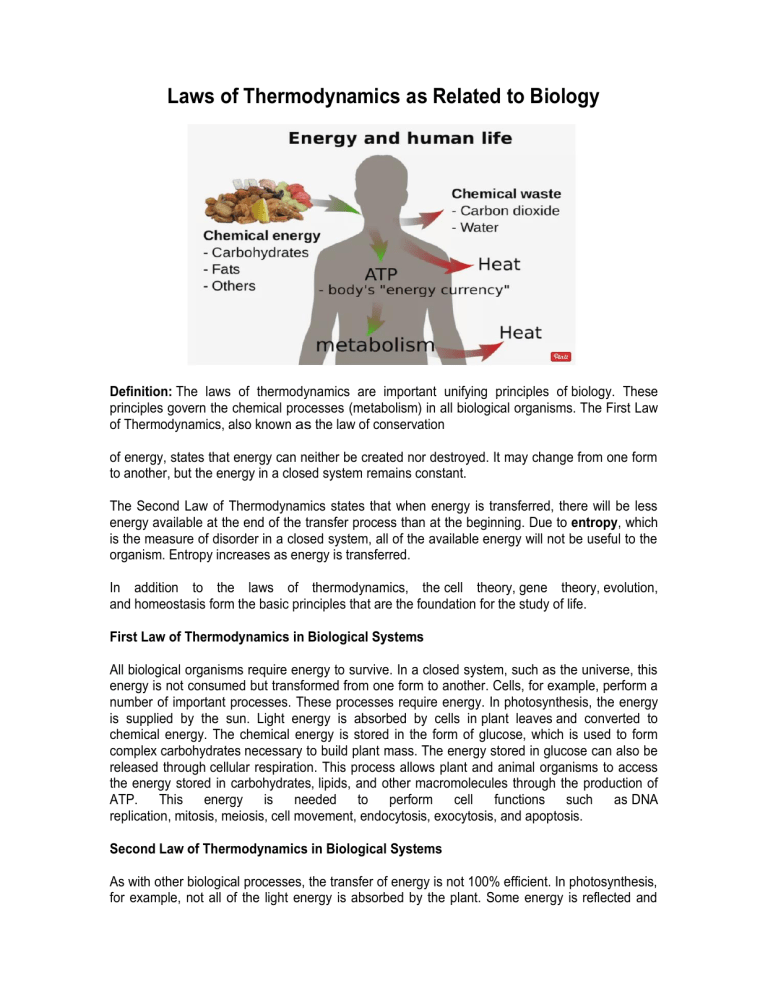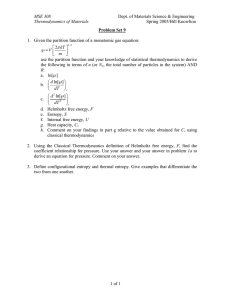
Laws of Thermodynamics as Related to Biology Definition: The laws of thermodynamics are important unifying principles of biology. These principles govern the chemical processes (metabolism) in all biological organisms. The First Law of Thermodynamics, also known as the law of conservation of energy, states that energy can neither be created nor destroyed. It may change from one form to another, but the energy in a closed system remains constant. The Second Law of Thermodynamics states that when energy is transferred, there will be less energy available at the end of the transfer process than at the beginning. Due to entropy, which is the measure of disorder in a closed system, all of the available energy will not be useful to the organism. Entropy increases as energy is transferred. In addition to the laws of thermodynamics, the cell theory, gene theory, evolution, and homeostasis form the basic principles that are the foundation for the study of life. First Law of Thermodynamics in Biological Systems All biological organisms require energy to survive. In a closed system, such as the universe, this energy is not consumed but transformed from one form to another. Cells, for example, perform a number of important processes. These processes require energy. In photosynthesis, the energy is supplied by the sun. Light energy is absorbed by cells in plant leaves and converted to chemical energy. The chemical energy is stored in the form of glucose, which is used to form complex carbohydrates necessary to build plant mass. The energy stored in glucose can also be released through cellular respiration. This process allows plant and animal organisms to access the energy stored in carbohydrates, lipids, and other macromolecules through the production of ATP. This energy is needed to perform cell functions such as DNA replication, mitosis, meiosis, cell movement, endocytosis, exocytosis, and apoptosis. Second Law of Thermodynamics in Biological Systems As with other biological processes, the transfer of energy is not 100% efficient. In photosynthesis, for example, not all of the light energy is absorbed by the plant. Some energy is reflected and some is lost as heat. The loss of energy to the surrounding environment results in an increase of disorder or entropy. Unlike plants and other photosynthetic organisms, animals cannot generate energy directly from the sunlight. They must consume plants or other animal organisms for energy. The higher up an organism is on the food chain, the less available energy it receives from its food sources. Much of this energy is lost during metabolic processes performed by the producers and primary consumers that are eaten. Therefore, much less energy is available for organisms in higher trophic levels. The lower the available energy, the less number of organisms can be supported. This is why there are more producers than consumers in an ecosystem. Living systems require constant energy input to maintain their highly ordered state. Cells, for example, are highly ordered and have low entropy. In the process of maintaining this order, some energy is lost to the surroundings or transformed. So while cells are ordered, the processes performed to maintain that order result in an increase in entropy in the cell's/organism's surroundings. The transfer of energy causes entropy in the universe to increase.





